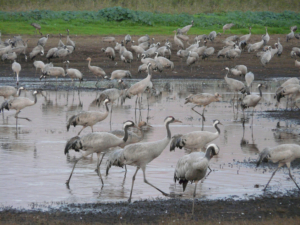Monitoring waterbirds that winter in the Camargue
Objectives
The aim of this project is to monitor the long-term trends of waterbird populations that winter in the Camargue, such as the Common Crane, the Great Cormorant, ducks, geese, and swans, as well as gulls, terns and waders. Our monitoring programmes can quantify the fluctuations in the abundance of species in response to global changes, and alert us about species conservation problems so we can propose more favourable management methods, or ways of controlling potentially problematic species such as the Yellow-legged Gull. These monitoring programmes are also site management tools, such as in the case of the lagoons and marshes of the former Camargue saltworks site [1].
Actions and methodology
A winter count is conducted every year in January for wintering Common Crane [2], whose population has risen significantly in the Camargue since the early 2000s.
A census is conducted every three years in January in the framework of a national census of wintering Great Cormorant. In the Camargue, there are 36 roosting sites roosts are concerned.
A count of ducks, geese, and swans, gulls, terns and waders as well as coots is made every month during the winter on the lagoons and marshes of the former Camargue saltworks site (LMCS), and every year in January in all the salinas in the Camargue (Aigues Mortes, Salin de Giraud, and LMCS). These censuses contribute to the mid-January counts carried out by Wetlands International.
Team
- Project leaders: Yves Kayser [3] & Jocelyn Champagnon [4]
- Staff involved: Antoine Arnaud [5], Thomas Blanchon [6], Marc Thibault [7]
- Date of project: Since 1968
Technical partners
- Réserve nationale de Camargue [8]
- Amis des Marais du Vigueirat [9]
- Parc naturel régional de Camargue [10]
- Syndicat mixte de la Camargue gardoise [11]
- Groupe SALINS [12]
- CNRS [13]
- Office National de la Chasse et de la Faune Sauvage [14]
- Wetlands International [15]
- Ligue pour la Protection des Oiseaux (LPO) Champagne-Ardenne [16]
Publication
- Kayser Y., Gauthier-Clerc M., Blanchon T., Vandewalle P., Befeld S., Petit J., Tiné R., Flitti A. & Champagnon J. (2018). L’hivernage de la Grue cendrée Grus grus en Camargue : historique et statut récent. Ornithos 25-1 : 4-13 (read more [17])
